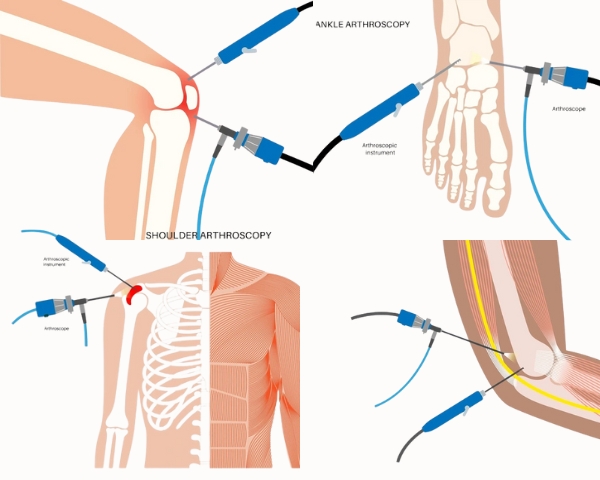Arthroscopic Surgery
Best Arthroscopy Surgeon in ahmedabad

Arthroscopy Surgery At Elite Hospital
Your Journey to Wellness begins here
Elite Hospital is backed by the best arthroscopy surgeon in Ahmedabad, a trusted name in minimally invasive arthroscopic surgery, offering advanced joint care through the expertise of our fellowship-trained orthopedic surgeons.
We combine precision techniques with the latest technology to diagnose and treat joint problems with smaller incisions, reduced pain, and faster recovery times. At the core of our approach is a commitment to personalised care, ensuring every patient receives a treatment plan tailored to their unique condition and lifestyle.
What is Arthroscopic Surgery ?
Arthroscopic surgery is a barely invasive procedure used to diagnose and treat problems inside a joint. A tiny tube known as an arthroscope is inserted through a tiny cut little larger than a buttonhole by the surgeon instead of a major cut.
This tiny tube has an attached camera and light which captures clear visuals of the inside of your joint to a high-definition monitor. The procedure is followed when the individual faces issues with joint pain, instability, or other problems that are interfering your day to day functioning.

Types of Arthroscopy Surgery
Knee Arthroscopy
Shoulder Arthroscopy
Hip Arthroscopy
Ankle Arthroscopy
Elbow Arthroscopy
Wrist Arthroscopy
Arthroscopy Surgery Procedure
Anesthesia
To ensure your comfort during the procedure, you will be given either local, regional, or general anesthesia
Small Incisions
The surgeon makes tiny incisions all around the joint
Arthroscope insertion
To observe the joint on a screen, a tiny tube equipped with a camera is entered
Diagnosis & Treatment
The surgeon uses small tools to remove or repair damaged tissues, such as torn ligaments or cartilage
Closing the Cuts
Stitches or tiny bandages are used to close the wounds
Why Choose Elite Hospital for Arthroscopy Surgery ?
Smaller incisions are preferred, which causes lesser pain, fewer scars, and a faster recovery. Therefore, you can return to regular activities more quickly.
Our skilled surgeons customise each procedure to provide you with long-term relief and best outcome, whether it involves repairing damaged ligaments, cartilage, or loose parts inside your joint.
Following surgery, we provide physiotherapy sessions for you. This makes easy return to regular activities, increases flexibility, and helps regain your strength.
We closely monitor your healing progress with routine follow-ups. This ensures any early detection of problems, if any and supports quick recovery.
Commonly Asked Questions
Q. For which conditions is Arthroscopic Surgery recommended?
Although arthroscopic procedures can be applicable to many other surgeries, they are usually used to reduce the symptoms of the following injuries or conditions:
- Tears in the rotator cuff
- Meniscal tears
- Both knee and hip arthritis
- Tears in the shoulder, hip, and knee ligaments
- Pain in the hands and wrists, including carpal tunnel syndrome
- Overuse ailments, such as tendon strains or ligament sprains
Q. What are the benefits of Arthroscopy?
Arthroscopic surgery offers a number of benefits due to its smaller incisions and specialised tools, such as less scars, less tissue disruption, a lower pain following surgery, less blood loss during the procedure, a shorter hospital stay, shorter time to get back to routine life, and more natural joint movement.
Q. What is the recovery process from Arthroscopic Surgery?
The cause for surgery and the procedure type determine the limitations following arthroscopic surgery. Following surgery, arthroscopy patients may feel some discomfort and inflammation, which is frequently addressed by rest and prescription painkillers.
Physiotherapy is recommended to patients based on the type of surgery.
Recovery from more complicated arthroscopic procedures may take up to 6 months, and patients will follow a progressive physiotherapy treatment.
Q. Are there risks associated with Arthroscopic Surgery?
Complications can arise with every surgical operation. Although fewer than 1% of treatments result in problems, these can include:
- Loss of blood
- Excessive swelling or a blood clot
- Infection
- Damage to normal structures
- Breakage of instruments
Patients should inform the surgical care team right away of problems or unexpected post-operative symptoms in order to guarantee a full recovery.
